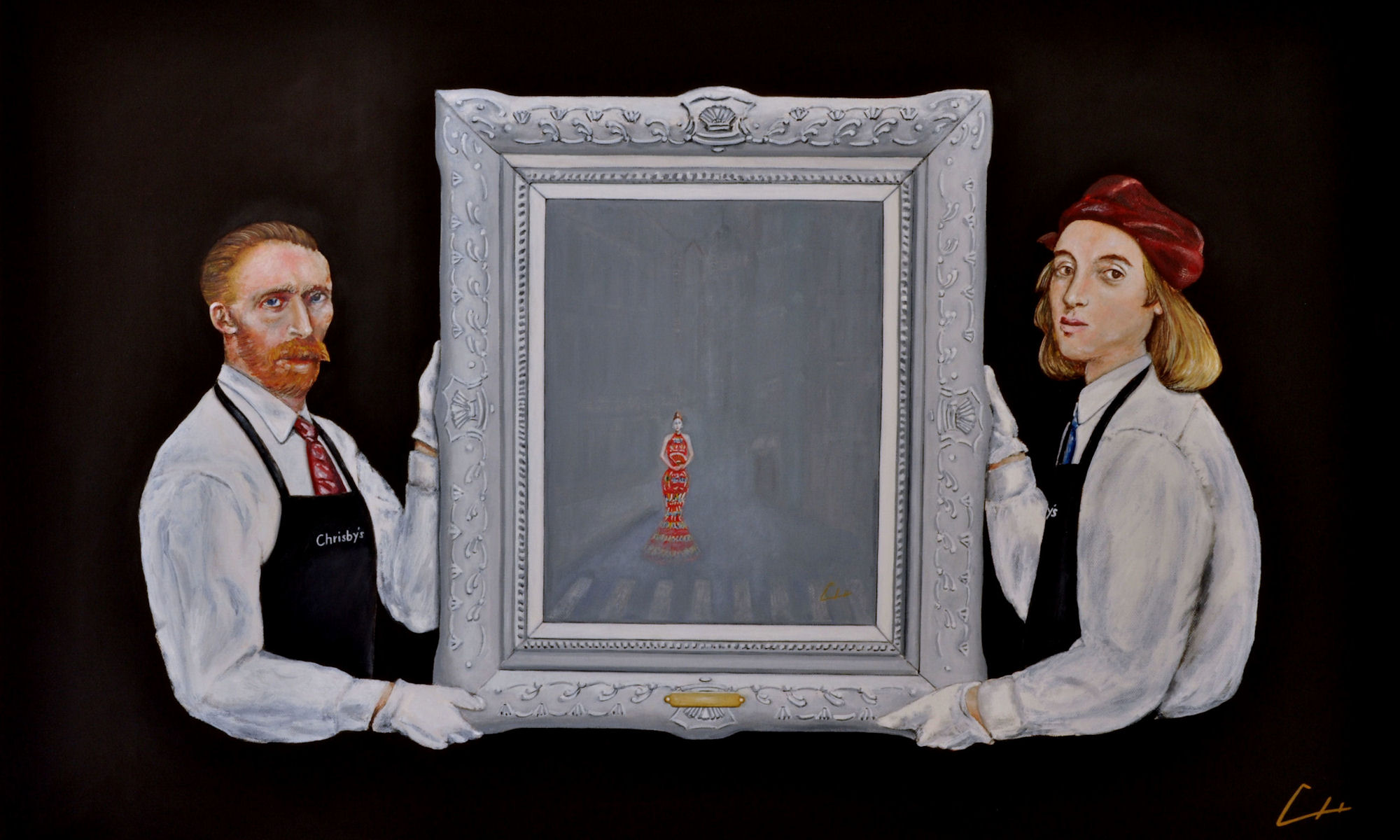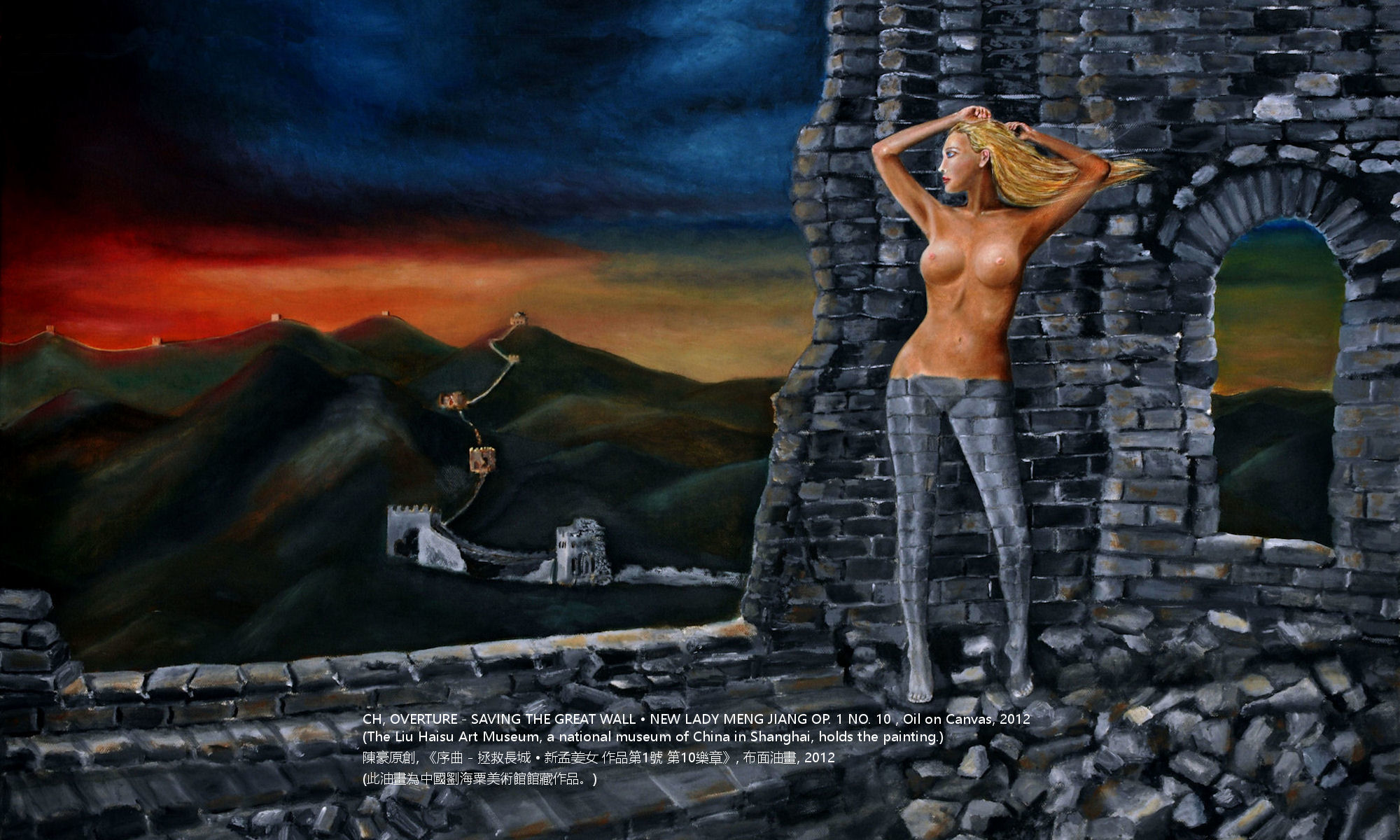POSTMODERN-NARRATIONISM
Overview of Introduction
“Narrationism (narrative faction)” or called “Postmodern-Narrationism” is a fine art style (just like Impressionism or other art styles). “Narrationism” this new English word and “Postmodern-Narrationism” were founded by the American painter, art theorist, and bilingual writer CH (Chen Hao).
Style Features
Postmodern-Narrationism applies postmodern’s methods to use the art tools, to “narrate” the story on the canvas or other artistic materials. Narrative types differ (eg: any unique events, fictions, fables or even if it’s just a slice of life). One of the early Postmodern-Narrationism artworks was CH’s “Space-age Mona” and published by the world’s largest photography magazine “Popular Photography” in 1991. This work won an international photo contest 1st prize winner in New York, USA. His other Postmodern-Narrationism representative works, such as the oil paintings “Louvre • Gehu”, “Saving the Great Wall • New Lady Meng Jiang”, “Paris • Woman Holding a Fan in Haze”, “After Hours”, “Pulse”, and so on. His oil painting “Overture – Saving the Great Wall • New Lady Meng Jiang Op. 1 No. 10” is held by the Liu Haisu Art Museum, a national museum of China in Shanghai. And his other early representative works, such as “Silent Night”, etc. are collected by the China Art Museum (China Art Palace), that is one of the largest art museums in Asia. Also, his artworks were selected in the art book Art and Art Market • Masters of the 21st Century that was published by the MAMAG Modern Art Museum in Austria 2017. Marquis Who’s Who (since 1899) in the United States, which the world’s most authoritative biographical information publishing company has already included his achievement in “Who’s Who in the World” (31st, 32nd, and 33rd edition) and “Who’s Who in America” (69th and 70th edition).
Creative Methods
Postmodern-Narrationism tries to place the things that correspond to each other on the same platform and space in the works. Such as East and West; Past and Present; Old and Young; Soft and Strong; Quiet and Noisy; Slow and Fast; Dark and Bright; Obsolete and Fashion, etc. In the painting, Postmodern-Narrationism is concrete realism, but not rigidly adhere to stroke skills. If only emphasizes painting skills, which is even as “realistic” as the photography or digital images, it loses the original style of painting and lacks a sense of times of the twenty-first century contemporary painting. If a work is no consciousness (even though that’s better than a photo), it is just a “Vegetative Painting”. Postmodern-Narrationism focuses on the ideological content and depth of artworks. A work, whether painting or others in the absence of ideology, it would mean no mind. If without mind, there is no life. If without life, it lacks long-term value. From ancient times to now, all the classic masterpieces of fine art are full of ideas works.
Artistic Point of Views
Due to introducing the literary elements, which makes the Postmodern-Narrationism artwork more richly contain ideological connotations and emotional energy. Therefore, Postmodern-Narrationism artworks are much like literature. Or called postmodern novel painting, fiction photography, and allegorical sculpture. The basic elements and features include: Symbolizing the Subject, Displaying the Comparison, Imagining the Implication, Expressing the Mentality, Granting the Dynamic, Delighting the Senses, Clearing the Character, Encouraging the Thinking, Transporting the Tense and Multiplexing the Lines, etc…
Longitudinal Exploration
Postmodern-Narrationism emphasizes on the art comes from real life, but distinguishes from the nineteenth century realism style which “faithfully” recorded what they actually saw everyday things. And Postmodern-Narrationism advocates that art is not just simply from natural life, but it is higher than the natural life after the creation of the artist. From the longitudinal contrast of painting techniques, although Postmodern-Narrationism and Expressionism (Abstract Art) are quite similar in emphasizing the intrinsic spirit of works, but “Concrete Realism” is an obvious difference between Postmodern-Narrationism and Abstract Art. However, Postmodern-Narrationism does not blindly pursue absolute stroke techniques. Hyperrealism, which was increasingly popular in the late 60s and early 70s of the last century in the west, was not and could not be expected today’s digital photography and internet technology to revolutionize on the visual arts.
From the Paleolithic Prehistoric Art to today’s iPad Finger Art, we easily find that one of the vitalities of artwork is its emotion and connotation, and should also be an organic unity of ideological contents, artistic skills, and visual joys.
Lateral Research
In the lateral comparison of narrative, there is specific comparability difficult between Postmodern-Narrationism of fine art category and “Postmodern Narrative” (or “Chinese Postmodern Narrative”) Theory of literature field. Even some of the Narrationism artworks contain the text part(s), such as CH’s Fiction Oil Painting Series: NUDE & GW & TCM, Mini-Novel Oil Paintings: IF ALL THE ICE MELTED, and so on. But this is only the bedding and comment to service for the painting part of the work. Since both belong to different areas of the fields, so we can only say the fine art of Postmodern-Narrationism looks like literature. Postmodern-Narrationism art is with the paintbrush(es), palette, pigment(s), camera(s) or graver(s) and other tools to “tell” the story on the art materials. Therefore, the creative processes of Postmodern-Narrationism and Postmodern Narrative are totally different.
In summary, although “Postmodern-Narrationism” (or called “Narrationism”) and “Postmodern Narrative” (or “Chinese Postmodern Narrative”) Theory both have “cooperation” or “marriage” (even the names are also very close), but in essence they belong to two separate individuals in two different areas.
後現代敘事派
概述簡介
“敘事派”或稱之為“後現代敘事派”,是一種藝術創作風格(如同印象派或其他藝術畫風和形式)。“Narrationism”這個全新的英語單詞和“後現代敘事派”(POSTMODERN-NARRATIONISM),是由美國油畫家, 藝術理論家和雙語作家陳豪(CH)創立的。
風格特點
後現代敘事派運用後現代的方法並通過使用藝術創作工具在畫布或其他藝術材料上“講述”後現代故事。敘事種類各異,如:任何獨特的或具有代表性的事件,小說,寓言或那怕只是一個生活片段。早期的後現代敘事派作品之一,是1991年發表在世界最大的攝影雜誌《大眾攝影》上,陳豪的“太空時代的蒙娜(麗莎)”。此作品並在美國紐約榮獲國際比賽第一名(第一個中國人獲此殊榮)。他的其他後現代敘事派代表作,如:油畫“盧浮宮 • 革胡”、“拯救長城 • 新孟姜女”、“巴黎 • 霧霾中拿扇的女子”、“閉館後”和“脈”,等。其中他的油畫代表作“序曲 – 拯救長城 • 新孟姜女 作品第1號 第10樂章”,為中國上海劉海粟美術館之館藏作品。其另兩幅後現代敘事派早期代表作《七月四日》和《平安夜》已由目前全亞洲最大的藝術博物館中國上海的中華藝術宮收藏。此外,他的藝術作品在2017年被入選奧地利MAMAG現代藝術博物館《藝術與藝術市場 • 21世紀的大師》畫冊。始於1899年全球最具權威的美國侯爵(Marquis Who’s Who)履歷信息出版社已把他的成績編入《世界名人錄》(第31、32和33版)和《美國名人錄》(第69和70版)。
創作方法
後現代敘事派試圖把許多彼此對應關聯的事物放在同一個平台和空間展現在藝術作品中。如:東方與西方、過去與現在、老邁與年輕、柔軟與剛強、安靜與嘈雜、緩慢與快速、黑暗與光明、過時與時新等。在繪畫上,後現代敘事派是具象寫實,但不拘泥於筆觸的技巧性。如果只強調繪畫的技能,甚至畫得像攝影和數碼照片一樣“逼真”,那就遺失了繪畫原有的風格和缺乏了廿一世紀手工繪畫的時代感。如果一幅作品沒有思想意識,即便畫得比照片還好那也只是一幅零思維“植物畫”。後現代敘事派著重關注藝術作品的內涵和深度。一幅作品無論是繪畫還是其他藝術表現形式如果缺乏思想意識,那就等於沒有頭腦。如果作品沒有頭腦,那就沒有生命。如果作品沒有生命,那就缺乏長久存在的價值。從古至今,可留傳久遠的藝術作品都是充滿思想情感內涵的佳作。
藝術觀點
由於“後現代敘事派”引進了文學元素,這使美術作品更加富有思想內涵和情感能量。因此,後現代敘事派藝術又像文學作品。或稱後現代小說繪畫,文學攝影和寓言雕塑等。基本要素和特點包括:主題的象徵性、事物的對比性、意蘊的想像性、心態的表達性、意識的取悅性、動態的賦予性、人物的簡捷性、思考的鼓勵性、時態的轉變性和線路的多維性……
縱向略探
後現代敘事派注重藝術來源於現實生活,但區別於十九世紀把日常所見的事物“忠實”記錄下來的寫實主義(派)的風格。並且後現代敘事派主張藝術不是單純地源於自然生活,而是經過藝術家的創作高於自然生話。從縱向繪畫的技巧對比,雖然後現代敘事派在強調作品內在精神上與表現派(抽象藝術)頗為相似,但“具象寫實”是後現代敘事派與其較明顯的不同之處。然而,後現代敘事派不一味追求絕對技巧性的表現手法。上世紀六十年代末七十年代初在西方逐漸流行的超寫實主義是無法也不可能預料今天的數碼攝影和網路科技對視覺藝術的革命性影響。從舊石器時代的洞窟藝術至當今的iPad指畫藝術,我們不難發現藝術作品真正的生命力之一是它的情感和內涵,而且還應該是思想性、艺术性和視覺性的有机统一。
橫向研討
在橫向敘事比較上,藝術範疇的後現代敘事派與文學領域的“後現代敘事”(或“類後現代敘事”)理論較難有具體的可比性。即便有些敘事派藝術作品包含文字部分,如:陳豪的小說油畫系列《裸體&長城&中醫》和微小說系列油畫《如果冰都融了》等。但這僅是為繪畫部分服務的鋪墊和註釋。由於“後現代敘事派”和“後現代敘事”兩者分屬不同領域範疇,因此我們僅能說後現代敘事派藝術“像”文學作品。後現代敘事派藝術主要是用畫筆、調色板、顏料、相機或刻刀等工具在藝術材料上“講述”故事。其與後現代敘事文學作品的創作過程是截然不同的。
綜上所述,“後現代敘事派”與“後現代敘事”理論兩者雖有“合作”或“聯姻”(甚至名字也僅差一字),但從本質上它們是分屬兩個不同領域範疇的兩個獨立個體。
(本页面的文字允许在知识共享 署名-相同方式共享 3.0协议和GNU自由文档许可证下修改和再使用。)

